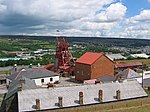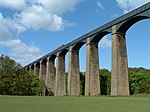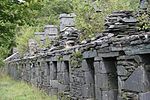List of World Heritage Sites in Wales

The United Nations Educational, Scientific and Cultural Organization (UNESCO) World Heritage Sites are places of importance to cultural or natural heritage as described in the UNESCO World Heritage Convention, established in 1972.[1] There are four UNESCO World Heritage Sites in Wales, as part of the 33 in the United Kingdom (UK) and the British Overseas Territories.[2]
The Castles and Town Walls of King Edward in Gwynedd (named after the then larger Gwynedd county) was the first site designated exclusively within Wales and alongside the other six sites in the United Kingdom first designated in 1986.[3] Whereas the Slate Landscape of Northwest Wales is Wales's newest site designated on 28 July 2021.[4] All of the World Heritage Sites in Wales are designated as "cultural".[5]
Ratification of the constitution of UNESCO was performed by the UK in 1946.[6] The United Kingdom National Commission for UNESCO advises the UK Government, which is overall responsible for maintaining World Heritage Sites across the UK, on policies regarding UNESCO.[7] The UK Government's Department for Culture, Media and Sport (DCMS) is the responsible department representing the UK's general compliance with the convention to UNESCO.[8] Nominating sites and co-ordinating directly to UNESCO is reserved to the UK Government, however the powers to oversee, protect and manage historic sites is devolved to Wales. Cadw, on behalf of the Welsh Government, is responsible to identify, submit and discuss potential World Heritage Site contenders or concerns over existing sites to the DCMS for review, as well as Wales's specific compliance to the convention in regards to local protection policy. Local authorities in Wales, through their spatial planning systems, have the responsibilities to oversee any potentially inappropriate development near World Heritage Sites and to develop local protection plans for the sites, if appropriate.[9][10][11][12]
World Heritage Sites
[edit]UNESCO lists sites under ten criteria; each entry must meet at least one of the criteria under either "cultural" or "natural". Criteria i through vi are "cultural", which applies to all of Wales's sites.[13]
| Site | Image | Location | Year listed | UNESCO data | Description |
|---|---|---|---|---|---|
| Blaenavon Industrial Landscape | 
|
Blaenavon[14] | 2000 | 984; 2000; iii, iv[14] |
In the 19th century, Wales was the world's foremost producer of iron and coal. Blaenavon is an example of the landscape created by the industrial processes associated with the production of these materials. The site includes quarries, public buildings, workers' housing, and a railway.[14] |
| Castles and Town Walls of King Edward in Gwynedd | 
|
Conwy, Isle of Anglesey and Gwynedd[15] | 1986 | 374; 1986; i, iii, iv[15] |
During the reign of Edward I of England (1272–1307), a series of castles was constructed in Wales with the purpose of subduing the population and establishing English colonies in Wales. The World Heritage Site covers many castles including Beaumaris, Caernarfon, Conwy, and Harlech. The castles of Edward I are considered the pinnacle of military architecture by military historians.[15][16] |
| Pontcysyllte Aqueduct and Canal | 
|
Trevor, Wrexham and Shropshire, England[17] | 2009 | 1303; 2009; i, ii, iv[17] |
The aqueduct was built to carry the Ellesmere Canal over the Dee Valley. Completed during the Industrial Revolution and designed by Scottish Engineer Thomas Telford, the aqueduct made innovative use of cast and wrought iron, influencing civil engineering across the world.[17][18] The heritage site extends into Shropshire in England.[19] |
| The Slate Landscape of Northwest Wales | 
|
Gwynedd | 2021 | 1633; 2021; ii, v[20] |
The six key areas, all located in Gwynedd, are: Penrhyn Slate Quarry and Bethesda, and the Ogwen Valley to Port Penrhyn; Dinorwig Slate Quarry Mountain Landscape; Nantlle Valley Slate Quarry Landscape; Gorseddau and Prince of Wales Slate Quarries, Railways and Mill; Ffestiniog: its Slate Mines and Quarries, 'city of slates' and Railway to Porthmadog; Bryneglwys Slate Quarry, Abergynolwyn Village and the Talyllyn Railway.[21] |
References
[edit]- ^ "The World Heritage Convention". UNESCO. Retrieved 17 September 2010.
- ^ United Kingdom of Great Britain and Northern Ireland: Properties inscribed on the World Heritage List, UNESCO, retrieved 23 July 2022
- ^ "The First 7 UK World Heritage Sites". The Historic England Blog. Historic England. 2016-11-24. Retrieved 2023-02-12.
- ^ "Welsh Slate Landscape UK's newest UNESCO World Heritage Site". GOV.UK. Retrieved 2021-07-28.
- ^ United Kingdom of Great Britain and Northern Ireland: Properties inscribed on the World Heritage List, UNESCO, retrieved 16 August 2009
- ^ UNESCO Constitution, UNESCO, retrieved 17 August 2009
- ^ About us, The United Kingdom National Commission for UNESCO, archived from the original on 28 February 2009, retrieved 17 August 2009
- ^ "Understanding World Heritage Sites in Wales | Cadw". cadw.gov.wales. Retrieved 2023-02-12.
- ^ "Understanding World Heritage Sites in Wales | Cadw". cadw.gov.wales. Retrieved 2023-02-12.
- ^ "Managing World Heritage Sites in Wales | Cadw". cadw.gov.wales. Retrieved 2023-02-12.
- ^ Concordat between the Department for Culture, Media and Sport and Welsh Assembly Government (PDF). Welsh Assembly Government. 13 May 2011. pp. 16–17.
- ^ Managing Change in World Heritage Sites in Wales (PDF). Cadw. May 2017.
- ^ "UNESCO World Heritage Centre The Criteria for Selection". UNESCO World Heritage Centre. Archived from the original on 12 June 2016. Retrieved 17 August 2018.
- ^ a b c Castles and Town Walls of King Edward in Gwynedd, UNESCO, retrieved 12 August 2009
- ^ Liddiard (2005), p. 9.
- ^ a b c Pontcysyllte Aqueduct and Canal, UNESCO, retrieved 12 August 2009
- ^ Listed Buildings: Pontcysyllte Aqueduct, Trevor, Wrexham County Borough Council, archived from the original on 13 October 2008, retrieved 12 August 2009
- ^ "Pontcysyllte Aqueduct & Canal World Heritage Site". Pontcysyllte Aqueduct and Canal World Heritage site. Retrieved 12 February 2023.
- ^ Slate Industry of North Wales, UNESCO, retrieved 17 July 2016
- ^ Wales Slate World Heritage Site Nomination


